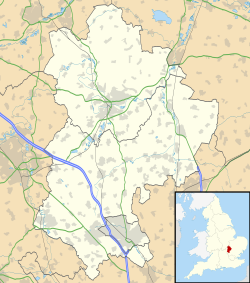History
Henlow was chosen as a military aircraft repair depot in 1917 and was built by MacAlpine during 1918. Four Belfast Hangars were built and are now listed buildings. [4] Henlow Camp, a civilian settlement, grew up around the base at that time. [5]
Originally a repair depot for aircraft from the Western Front, the Station officially opened on 18 May 1918 when Lt Col Robert Francis Stapleton-Cotton arrived with a party of 40 airmen from Farnborough. In May 1920, RAF Henlow became the first parachute testing centre [6] and was later joined by another parachute unit from RAF Northolt. Parachute testing was undertaken with Vimy aircraft and parachutists hanging off the wings and allowing the chute to deploy and enable them to drift back to the ground. [7] The Officers Engineering School moved there in 1924 from Farnborough.
After the First World War, Henlow was home to four aircraft squadrons; No. 19 Squadron RAF, No. 23 Squadron RAF, No. 43 Squadron RAF and No. 80 Squadron RAF. [9] Between 1932 and 1933, Sir Frank Whittle was a student at the RAF technical College on the base. He later spent some time in charge of aero engine testing on the base before being sent to Cambridge. [11] An additional hangar was added to the inventory in the 1930s and this too is now listed. [12]
During the Second World War Henlow was used to assemble the Hawker Hurricanes which had been built at the Hurricane factory operated by Canadian Car and Foundry in Fort William, Ontario, Canada, under the leadership of Elsie MacGill. After test flying in Fort William, they were disassembled and sent to Henlow in shipping containers and reassembled. During Operation Quickforce in 1941, 100 fitters from the base were deployed onto carriers which were shipping Hurricane fighters to Malta. [14] The finished Hurricanes were completed on the decks of the carriers and flown out to Malta. [15] Over 1,000 Hurricanes (about 10% of the total) were built by Canadian Car and Foundry and shipped to Henlow. Henlow was also used as a repair base for many aircraft types under the direction of No. 13 Maintenance Unit.
The empty packing crates that the Hurricane aircraft were shipped in were used to make the original control tower (which has now been replaced by a more modern two-storey Portakabin type). [18] The original tower and parts of the airfield were seen in several scenes in the 1969 war film 'The Battle of Britain'. [19]
A major RAF technical training college was also formed at Henlow in 1947. This was formed from the RAF School of Aeronautical Engineering, formerly at RAF Farnborough, and its purpose was to train cadets and engineering officers. [20] The college was amalgamated with RAF College Cranwell in 1965. [21] The RAF Officer Cadet Training Unit then moved in, but this also moved to Cranwell in 1980. [22]
Henlow then hosted the RAF Signals Engineering Establishment and the Radio Engineering Unit, established in 1980. In 1983, the Land Registry took over part of the site.
In December 2011, RAF Henlow along with 14 other Ministry of Defence sites in the United Kingdom were designated as being dangerously radioactive. The 15 bases were poisoned by "radium that was used to coat the dials of aircraft...so that they could be seen in the dark" during the Second World War. [24]
Administratively, RAF Henlow was part of a combined base, RAF Brampton Wyton Henlow, until RAF Brampton was closed in 2013. [25]
Flying activity ceased in July 2020. [26]
This page is based on this
Wikipedia article Text is available under the
CC BY-SA 4.0 license; additional terms may apply.
Images, videos and audio are available under their respective licenses.



